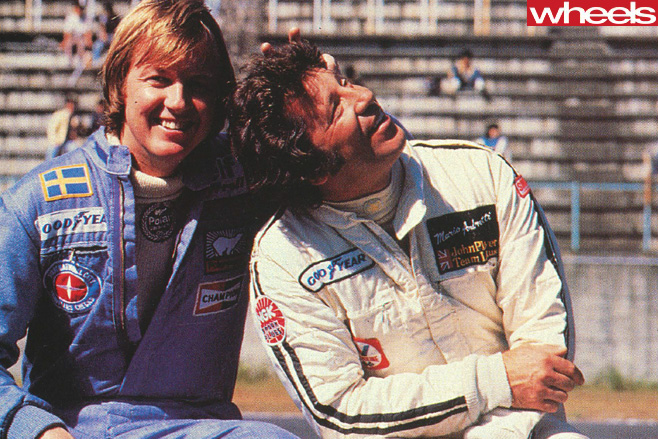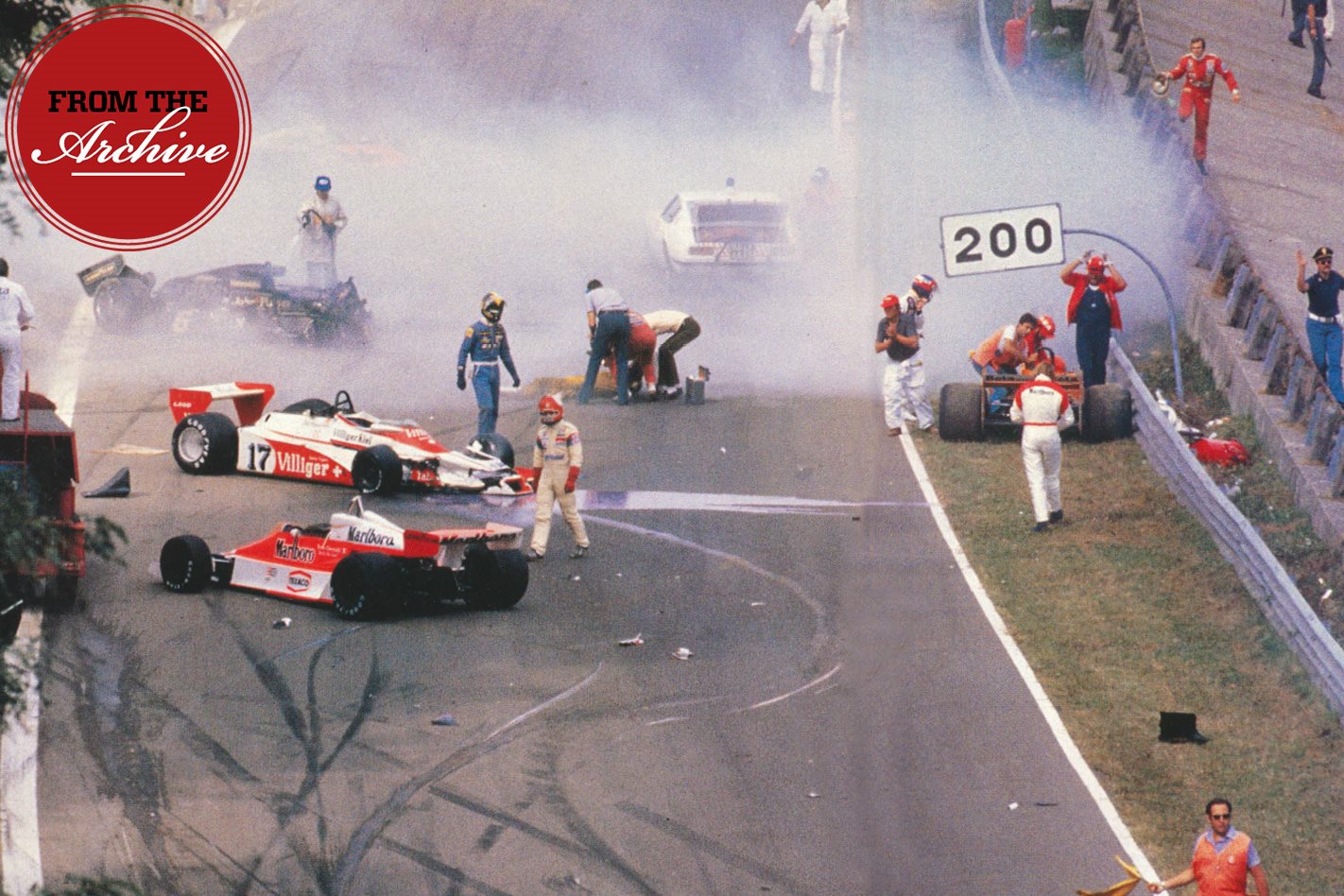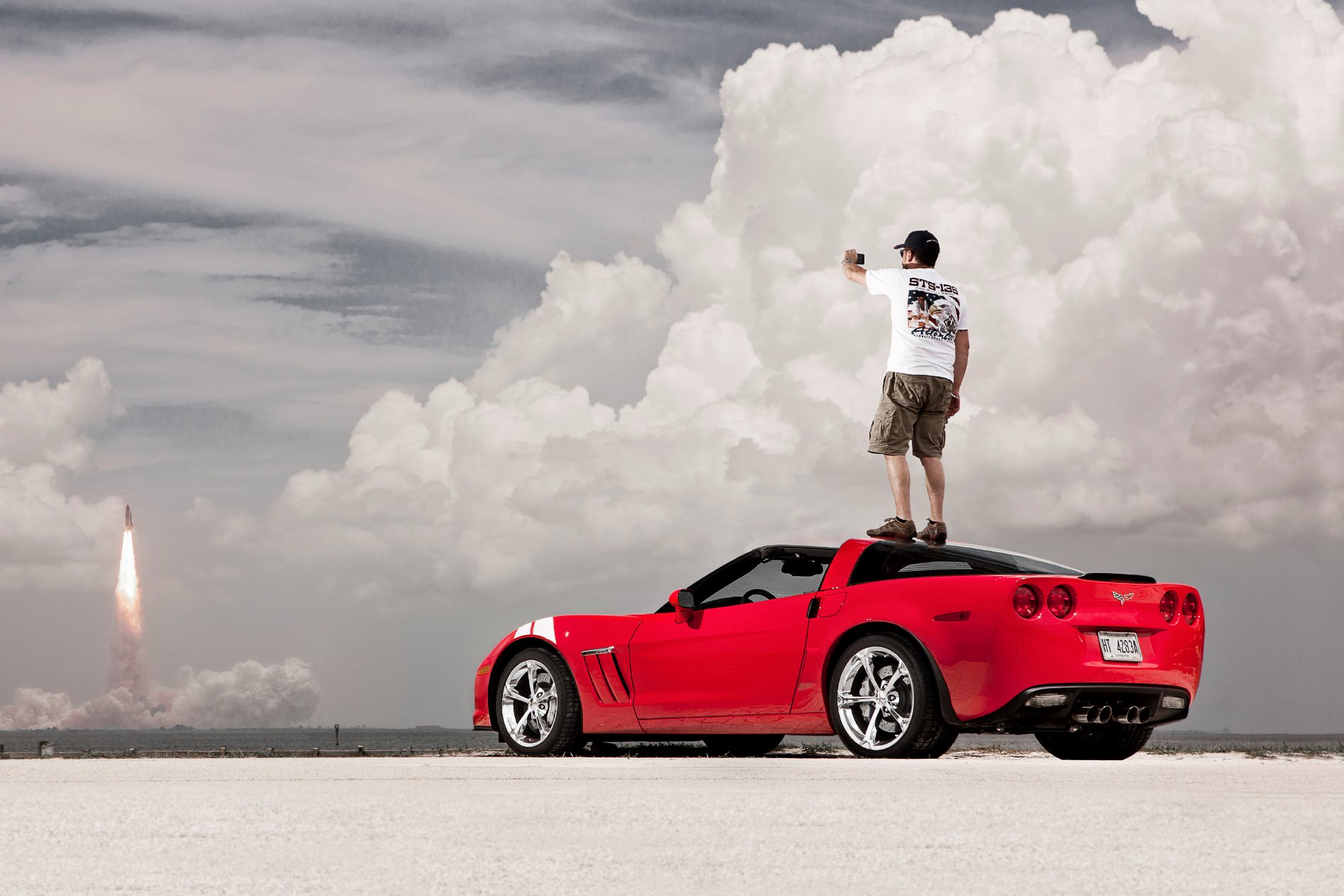First published in the August 1997 issue of Wheels magazine, Australia’s best car mag since 1953.
Ronnie Peterson’s death at the 1978 Italian Grand Prix shocked the F1 world – and scandalised the way F1 handled the medical treatment of drivers.
As the inquiry into Ayrton Senna‘s death clouds the future of grand prix racing in Italy, PETER ROBINSON reveals the untold story behind another death that forever changed the face of F1
It was not an auspicious beginning. During the morning warm-up for the Italian Grand Prix at Monza in September, 1978, Ronnie Peterson’s Lotus 79 had mowed down several layers of catch fencing. For the race, he would start in the old 78. “Bloody rear brakes again,” he told Mario Andretti. “Just like yesterday.”
“You okay?” Mario asked. “Yes,” Ronnie said, rubbing his leg. “Just bruised.”
Ronnie and Mario were team mates. The blonde Swedish driver had come back to Lotus in an attempt to restore his reputation after some terrible seasons in the ageing and increasingly uncompetitive Lotus 72, a March and then Tyrrell’s dead-end six-wheeler. People said his magic days were over.
He wanted to prove they were wrong.
Peterson was prepared to accept team orders and run behind the American. Throughout the season he honoured his contract, even after it was clear he would not be staying at Lotus the following year. And in terms of raw talent, he could have beaten Andretti for the championship.
But Peterson was not like that. There was no guile, for this was a quiet, gentle, honest man. Yet nobody could make a car dance the way Ronnie did. There are those who still say there has never been a finer sight in all motor racing than to see Ronnie – everybody called him Ronnie – tiptoeing the Lotus 72 through the old 250km/h Woodcote corner at Silverstone. Tail out, Ronnie made the 72 oversteer at seemingly impossible angles and always seemed to be able to catch it. No driver was ever more exciting to watch. Not Rindt, not Senna, not Mansell. Nobody.

Ronnie was seriously injured, but in no apparent danger. Most people left Monza that night expecting Peterson to spend a stint in hospital before resuming his career next season. Next morning he was dead.
If Ronnie had been operated on in Sweden he would still be alive today,” says Pierangelo ‘Peter’ Varolo.
Varolo was the last person to speak to Ronnie before he died. Now 68 and winding down his medical practice, Varolo is well qualified to make this seemingly harsh judgement. You see, the doctor has a possibly unique combination of qualifications that took him to Peterson’s deathbed and guarantee that his words deserve a hearing 19 years on.
Varolo has three Italian medical degrees – general (1958), orthopaedic (1962) and legal (1964), from the Turin University – together with a Swedish orthopaedic degree (1969) which, by necessity, means he is also fluent in Swedish. For 10 years Varolo lived in Sweden, for three of these with his Swedish wife.
It was as a widower that he returned to Italy in 1972. On Sunday; September 11, 1978, Peter V arolo, now remarried, was watching the Italian Grand Prix on television at his home about 80km east of Monza. “I thought nothing of the accident,” he says today. “On television they talked about minor injuries to his legs. There was nothing to make you think it was serious.” Until he watched the evening news at 8.00pm.
“It was only then I heard he was going to be operated on and I wondered why it took so long,” says Varolo.
“If the injuries were only light, they should have been repaired immediately.
“In my opinion, if there was to be an operation they should have flown him immediately to Sweden.
“I became increasingly suspicious that something had gone wrong. Logically, he should have been treated by 8.00pm, five hours after the accident. I thought maybe I could help because I speak Swedish and have orthopaedic experience.
“My wife suggested I ring the hospital mentioned in the news: Niguarda, north of Milan. I rang and told them I was a Swedish doctor, and they asked me to come.”
Monza traffic slowed the journey and even Varolo’s Maserati Mexico, which he still drives, couldn’t get him to Niguarda before 11.00pm. As he entered the hospital, Varolo remembers hearing a Swede talking before getting into a Rolls-Royce and driving away. He later leamed that this was Steffan Svenby, Peterson’s manager.
Immediately, he was shown to the operating room. Colin Chapman, Mario Andretti, Emerson Fittipaldi and Bernie Ecclestone were still there, but they soon left because they believed Ronnie
was going to be okay. “Some Swedish friends of Ronnie’s and a few journalists were still waiting outside,” says Varolo.
“They wanted me to find out what was happening.”
Ronnie had multiple fractures of both legs, but Varolo believes that the injuries should not have been life threatening. Professor Sid Watkins, employed just three months’ earlier at the behest of Bernie Ecclestone as F1’s surgical advisor, was present.
But Watkins is a neurosurgeon and Peterson’s injuries were to his bones.
“There were seven or eight doctors in the room and I spoke to the head surgeon. They had just finished operating on the right femur. I knew that wasn’t necessary, it was an unpardonable mistake; they hadn’t touched his feet, the area most urgently in need of care.
“In Sweden we always waited a week before operating on the femur. The danger is bone-marrow getting into the lungs through the blood. We knew by experience that if the lungs became inundated with blood we’d have to give many blood transfusions. During that week we’d take daily X-rays to check the condition of the lungs.
“I would never have started on the femur, the risk was too great. The important thing was to treat the left foot, to put the bones in place, back where they belong. It was the left foot that was most injured and it was still untreated at 2.00am. Because the bones were isolated they weren’t getting any aerated blood. The navicular bone in the foot was subject to necrosis- the death of tissue- but it wasn’t treated until about 2.00am, 10 hours after the accident.
“There was a higher risk of fat emboli from the multiple fractures and especially from the femur. They should have left it alone.
“I asked why they had operated on the femur first and they told me it was because Ronnie had bums on his back and it was easier to move the patient. It was five hours before they operated at all, they took many X-rays, but nothing was decided.
“I assume it was because the head surgeon wasn’t there and they waited for him to arrive, but it’s a theory. How can you explain why they did not immediately start operating on his feet?”
At about 3.00am, after the long operation and as the anaesthetic was wearing off, Varolo attempted to wake Ronnie: “Vakna, vakna, Ronnie,” he called, speaking to Peterson in his native tongue. Ronnie stirred, reacting slightly to the cry to wake, then his head slumped back into the pillow.
Ronnie was taken away to be X-rayed at around 3.30am and, immediately on seeing the film Varolo understood. “I saw the lungs were clouded over and therefore were full of blood containing the bone marrow and I knew there was no hope. He was finished.”
Umberto Agnelli, a friend of Ronnie’s and the brother of Giovanni, the head of Fiat, rang at around 6.00am to see if there was any news.
“I told him Ronnie was dead, there was nothing to be done.”
That morning, Varolo also remembers hearing Svenby talking to Ronnie’s father on the phone, in Swedish. “He told him the operation went well, that they had been there all night, until the very end, and that everything possible had been done. Svenby had left at 11.00pm.”
After the operation and at Svenby’s behest, Varolo, Sid Watkins and a young Colombian doctor employed by Lotus, who was also present, signed a document saying they would not subsequently talk about the operation. But not before Varolo had spoken to a couple of Swedish journalists.
In his autobiography, Life at the Limit, Sid Watkins makes no mention of this secrecy. However, he does say that at about four in the morning he had a phone call from Peterson’s manager who told him, “things had taken a bad turn for Ronnie”.
“On the way to the hospital, he told me that during the night somebody claiming to be a doctor had telephoned Barbro (Ronnie’s wife who was at home in Monte Carlo), to tell that he thought the Italian doctors were killing her husband. We were never able to get to the bottom of who this person was, but it was suspected that the miscreant had impersonated medical staff in order to get into the hospital.”
Varolo’s comments were reported in the Swedish papers, and picked up the following day in Italy. Initially, the Italian papers had claimed Peterson died of petrol fumes in the lungs. “I told the Swedish journalists they (the Italian doctors) had operated too much and made a mess of it,” says Varolo.
The Italian papers and Autosprint magazine (September 19-26, 1978) quoted Varolo secondhand.
“I must criticise the manner in which they treated Peterson. In Sweden we would never have made a intervention so complicated on a person so weak from his injuries. He should have been sent to Sweden immediately.”
Why did Peter Varolo sign the no-talking document?
“I realised it was useless to fight,” he says today. “It could have been a catastrophe for Italy and the scandal would have meant F1 was finished in Italy. Now I’m retiring I’m prepared to talk.”
“It was ridiculous. If the accident had happened in Sweden, I don’t think Ronnie would have died.”
Peterson’s untimely death triggered a profound – and long overdue – change in F1 safety thinking. It decisively challenged the view that F1 drivers necessarily stared death in the face at every race; a view so entrenched that when Jackie Stewart began his safety campaign in the ’60s, traditionalists derisively called him and others the “milk and water brigade”.
Despite Stewart’s best efforts, Sid Watkins found that even in the late ’70s many tracks had little more than the most basic first-aid facilities. A mobile hospital largely funded by BRM owner Louis Stanley in the late ’60s was actually boycotted by some.
Few had workable plans for the rapid transfer of badly injured drivers to nearby hospitals. And Ronnie’s crash had pointed to the need for medical back-up to be instantly on the scene of a crash.
“One of the problems at Monza was that from the moment of the accident there was no information, and once the circuit had been sealed off by the police there was no access,” says Watkins. In the aftermath, Ecclestone came to the conclusion that Watkins’ authority had to be extended to supervising the rescue arrangements on the circuit.
Driven largely by Watkins – with Ecclestone’s support – safety slowly became a key element of F1 organisation. Races were all started by an official FIA starter, to minimise the risk of confusion, and circuits were obliged to provide fast chase cars with rapid response medical teams.
Helicopters for hospital transfers were made mandatory in 1986, while race cars were being crash tested and circuits redesigned to cut out danger points. By the early 1990s it seemed Formula One had banished its bloodsport image forever – since Riccardo Paletti’s death on the grid of the ’82 Canada GP, no driver had been fatally injured in a race crash. Then came that fateful weekend at Imola in May 1994…





